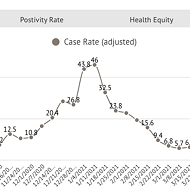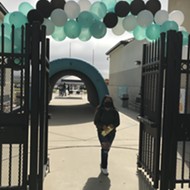Special districts left out of COVID-19 relief funds, support bill for future assistance
By Karen Garcia[{
"name": "Ad - Medium Rectangle CC01 - 300x250",
"id": "AdMediumRectangleCC01300x250",
"class": "inlineCenter",
"insertPoint": "8",
"component": "2963441",
"requiredCountToDisplay": "12"
},{
"name": "Ad - Medium Rectangle LC01 - 300x250",
"id": "AdMediumRectangleCC01300x250",
"class": "inlineCenter",
"insertPoint": "18",
"component": "2963441",
"requiredCountToDisplay": "22"
},{
"name": "Ad - Medium Rectangle LC09 - 300x250",
"id": "AdMediumRectangleLC09300x250",
"class": "inlineCenter",
"insertPoint": "28",
"component": "3252660",
"requiredCountToDisplay": "32"
}]
In the state of California, community services districts (CSDs) are feeling the effects of COVID-19 but unlike other local government entities, they were left out of coronavirus relief packages. And that’s why Central Coast CSDs are submitting letters of support for federal legislation that would make them eligible for future relief funds.
House Resolution 7073, the Special Districts Provide Essential Services Act, proposes to make special districts eligible for payments from the Coronavirus Relief Fund if more than $150 billion is appropriated to the fund.
The Templeton, Cambria, and Los Osos CSDs and the Cambria Community Healthcare District, Coastal San Luis Resource Conservation District, and Upper Salinas-Las Tablas Resource Conservation District have all sent letters in support of the bill.
Templeton’s CSD provides water, wastewater, fire and emergency services, parks and recreation, trash, street lights, and some drainage service to 8,000 residents.
During the public health crisis thus far, Templeton CSD District Manager Jeff Briltz told New Times, the district has provided staff with the proper personal protective equipment and modified district facilities to follow state guidelines. In addition to those cost increases, the district waived late fees for nonpayment or late payment for water and sewer bills to help individuals who might be facing economic hardship, Briltz said.
Parks and recreation has felt the largest impact, as almost all of the department’s programs—from youth sports to concerts in the parks—have been shuttered or are on hold. As a result, the district refunded registration costs back to community members. Briltz said the district has also made the tough decision to furlough three parks and recreation staff as well. At this time, the district stands to lose approximately 55 to 65 percent of its revenue—about $100,000.
“But if we can’t have soccer in the fall, that’ll be $200,000. It keeps growing, and I know that’s not a big number when you compare it to what the county’s impacts are or cities with their loss of [transient occupancy tax] or sales tax and our other revenue sources have been fairly stable. But remember, we’re a very small agency to begin with,” Briltz said.
The California Special Districts Association conducted a survey in May of all special districts within the state to get an understanding of how COVID-19 was impacting their budgets, association Public Affairs Field Coordinator Cole Karr said.
“At that point in the pandemic, collectively, what we received back and what we were able to assess from that was about a $250 million impact on special district services for their budgets. That’s in terms of their expenditures and revenue losses that had been incurred up until about May 5 and was due to COVID-19,” Karr said.
The survey also found that about 66 percent of special districts have annual operating revenues of about $5 million or less, and about 40 percent have operating revenues of $1 million or less.
Part of the reason special districts were ineligible for relief funds is that the U.S. Department of Treasury didn’t consider special districts to be a local unit of government under the Cares Act for the Coronavirus Relief Fund. There isn’t a federal definition for “special district.”
“We had a number of districts across the state that actually served more than 500,000 people and would have otherwise been eligible for direct access to the funding. They attempted to certify and the Treasury did not certify them, which set up the concern that any future allocations of the Coronavirus Relief Fund, if it were to be broadened and more accepting of governments fewer than 500,000, we would not be included in that—we being special districts,” Karr said.
Local units of government, as defined within the Cares Act, include cities, counties, parishes, towns, and townships—but not special districts.
HR 7073 was introduced to the House Oversight and Reform and Financial Services committees, but the House isn’t currently in session. Due to the virus, Karr said, the process to get the bill passed could take longer than usual.
In a statement to New Times, bill co-sponsor U.S. Rep. Salud Carbajal (D-Santa Barbara) said that special districts provide vital local government services and are especially critical right now as communities continue to grapple with the effects of COVID-19.
“Despite their important role, special districts across California and the Central Coast have been left out of crucial federal assistance. I’m proud to be an original co-sponsor of this bill and will continue working to include special districts in future coronavirus relief packages, along with state, county, and city governments,” the statement read. ∆
House Resolution 7073, the Special Districts Provide Essential Services Act, proposes to make special districts eligible for payments from the Coronavirus Relief Fund if more than $150 billion is appropriated to the fund.
The Templeton, Cambria, and Los Osos CSDs and the Cambria Community Healthcare District, Coastal San Luis Resource Conservation District, and Upper Salinas-Las Tablas Resource Conservation District have all sent letters in support of the bill.
Templeton’s CSD provides water, wastewater, fire and emergency services, parks and recreation, trash, street lights, and some drainage service to 8,000 residents.
During the public health crisis thus far, Templeton CSD District Manager Jeff Briltz told New Times, the district has provided staff with the proper personal protective equipment and modified district facilities to follow state guidelines. In addition to those cost increases, the district waived late fees for nonpayment or late payment for water and sewer bills to help individuals who might be facing economic hardship, Briltz said.
Parks and recreation has felt the largest impact, as almost all of the department’s programs—from youth sports to concerts in the parks—have been shuttered or are on hold. As a result, the district refunded registration costs back to community members. Briltz said the district has also made the tough decision to furlough three parks and recreation staff as well. At this time, the district stands to lose approximately 55 to 65 percent of its revenue—about $100,000.
“But if we can’t have soccer in the fall, that’ll be $200,000. It keeps growing, and I know that’s not a big number when you compare it to what the county’s impacts are or cities with their loss of [transient occupancy tax] or sales tax and our other revenue sources have been fairly stable. But remember, we’re a very small agency to begin with,” Briltz said.
The California Special Districts Association conducted a survey in May of all special districts within the state to get an understanding of how COVID-19 was impacting their budgets, association Public Affairs Field Coordinator Cole Karr said.
“At that point in the pandemic, collectively, what we received back and what we were able to assess from that was about a $250 million impact on special district services for their budgets. That’s in terms of their expenditures and revenue losses that had been incurred up until about May 5 and was due to COVID-19,” Karr said.
The survey also found that about 66 percent of special districts have annual operating revenues of about $5 million or less, and about 40 percent have operating revenues of $1 million or less.
Part of the reason special districts were ineligible for relief funds is that the U.S. Department of Treasury didn’t consider special districts to be a local unit of government under the Cares Act for the Coronavirus Relief Fund. There isn’t a federal definition for “special district.”
“We had a number of districts across the state that actually served more than 500,000 people and would have otherwise been eligible for direct access to the funding. They attempted to certify and the Treasury did not certify them, which set up the concern that any future allocations of the Coronavirus Relief Fund, if it were to be broadened and more accepting of governments fewer than 500,000, we would not be included in that—we being special districts,” Karr said.
Local units of government, as defined within the Cares Act, include cities, counties, parishes, towns, and townships—but not special districts.
HR 7073 was introduced to the House Oversight and Reform and Financial Services committees, but the House isn’t currently in session. Due to the virus, Karr said, the process to get the bill passed could take longer than usual.
In a statement to New Times, bill co-sponsor U.S. Rep. Salud Carbajal (D-Santa Barbara) said that special districts provide vital local government services and are especially critical right now as communities continue to grapple with the effects of COVID-19.
“Despite their important role, special districts across California and the Central Coast have been left out of crucial federal assistance. I’m proud to be an original co-sponsor of this bill and will continue working to include special districts in future coronavirus relief packages, along with state, county, and city governments,” the statement read. ∆
—Karen Garcia
Latest in SLO the virus
Comments
Showing 1-1 of 1









